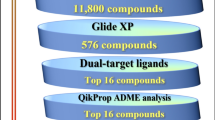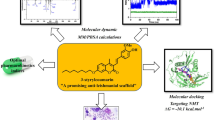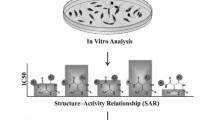Abstract
Leishmania protozoans are the causative agent of leishmaniasis, a neglected tropical disease consisting of three major clinical forms: visceral leishmaniasis (VL), cutaneous leishmaniasis, and mucocutaneous leishmaniasis. VL is caused by Leishmania donovani in East Africa and the Indian subcontinent and by Leishmania infantum in Europe, North Africa, and Latin America, and causes an estimated 60,000 deaths per year. Trypanothione reductase (TR) is considered to be one of the best targets to find new drugs against leishmaniasis. This enzyme is fundamental for parasite survival in the human host since it reduces trypanothione, a molecule used by the tryparedoxin/tryparedoxin peroxidase system of Leishmania to neutralize the hydrogen peroxide produced by host macrophages during infection. Recently, we solved the X-ray structure of TR in complex with the diaryl sulfide compound RDS 777 (6-(sec-butoxy)-2-((3-chlorophenyl)thio)pyrimidin-4-amine), which impairs the parasite defense against the reactive oxygen species by inhibiting TR with high efficiency. The compound binds to the catalytic site and engages in hydrogen bonds the residues more involved in the catalysis, namely Glu466′, Cys57 and Cys52, thereby inhibiting the trypanothione binding. On the basis of the RDS 777–TR complex, we synthesized structurally related diaryl sulfide analogs as TR inhibitors able to compete for trypanothione binding to the enzyme and to kill the promastigote in the micromolar range. One of the most active among these compounds (RDS 562) was able to reduce the trypanothione concentration in cell of about 33% via TR inhibition. RDS 562 inhibits selectively Leishmania TR, while it does not inhibit the human homolog glutathione reductase.






Similar content being viewed by others
Abbreviations
- FAD:
-
Flavin dinucleotide
- GSSG:
-
Oxidized glutathione
- hGR:
-
Human glutathione reductase
- IR:
-
Infrared
- NADPH:
-
Reduced nicotinamide adenine dinucleotide
- TR:
-
Trypanothione reductase
- TryS:
-
Trypanothione synthetase
- TS2 :
-
Trypanothione [N1,N8-bis(glutathionyl)spermidine]
- T(SH)2 :
-
Reduced trypanothione
- TXN:
-
Tryparedoxin
- TXNPx:
-
Tryparedoxin peroxidase I
- VL:
-
Visceral leishmaniasis
References
Bailey S, Smith K, Fairlamb AH, Hunter WN (1993) Substrate interactions between trypanothione reductase and N1-glutathionylspermidine disulphide at 0.28-nm resolution. Eur J Biochem FEBS 213:67–75
Baiocco P, Colotti G, Franceschini S, Ilari A (2009a) Molecular basis of antimony treatment in leishmaniasis. J Med Chem 52:2603–2612. https://doi.org/10.1021/jm900185q
Baiocco P, Franceschini S, Ilari A, Colotti G (2009b) Trypanothione reductase from Leishmania infantum: cloning, expression, purification, crystallization and preliminary X-ray data analysis. Protein Pept Lett 16:196–200
Baiocco P, Ilari A, Ceci P, Orsini S, Gramiccia M, Di Muccio T, Colotti G (2011) Inhibitory effect of silver nanoparticles on trypanothione reductase activity and Leishmania infantum proliferation. ACS Med Chem Lett 2:230–233. https://doi.org/10.1021/ml1002629
Baiocco P et al (2013) Inhibition of Leishmania infantum trypanothione reductase by azole-based compounds: a comparative analysis with its physiological substrate by X-ray crystallography. ChemMedChem 8:1175–1183. https://doi.org/10.1002/cmdc.201300176
Bhattacharya A, Biswas A, Das PK (2009) Role of a differentially expressed cAMP phosphodiesterase in regulating the induction of resistance against oxidative damage in Leishmania donovani. Free Radic Biol Med 47:1494–1506. https://doi.org/10.1016/j.freeradbiomed.2009.08.025
Burza S, Croft SL, Boelaert M (2018) Leishmaniasis. Lancet 392:951–970. https://doi.org/10.1016/S0140-6736(18)31204-2
Colotti G, Ilari A (2011) Polyamine metabolism in Leishmania: from arginine to trypanothione. Amino Acids 40:269–285. https://doi.org/10.1007/s00726-010-0630-3
Colotti G, Baiocco P, Fiorillo A, Boffi A, Poser E, Chiaro FD, Ilari A (2013a) Structural insights into the enzymes of the trypanothione pathway: targets for antileishmaniasis drugs. Future Med Chem 5:1861–1875. https://doi.org/10.4155/fmc.13.146
Colotti G et al (2013b) Metal-based compounds as prospective antileishmanial agents: inhibition of trypanothione reductase by selected gold complexes. ChemMedChem 8:1634–1637. https://doi.org/10.1002/cmdc.201300276
Colotti G, Fiorillo A, Ilari A (2018) Metal- and metalloid-containing drugs for the treatment of trypanosomatid diseases. Front Biosci (Landmark Ed) 23:954–966
Comini MA, Flohé L (2013) Trypanothione-based redox metabolism of trypanosomatids. In: Jäger T, Koch O, Flohé L (eds) Trypanosomatid diseases. Wiley-VCH Verlag GmbH & Co. KGaA, Hoboken, pp 167–199. https://doi.org/10.1002/9783527670383.ch9
Costi R et al (2000) Structure-activity relationship studies on potential non-nucleoside DABO-like inhibitors of HIV-1 reverse transcriptase. Antivir Chem Chemother 11:117–133. https://doi.org/10.1177/095632020001100204
Desjeux P (2004) Leishmaniasis: current situation and new perspectives. Comp Immunol Microbiol Infect Dis 27:305–318. https://doi.org/10.1016/j.cimid.2004.03.004
Dixon MJ, Maurer RI, Biggi C, Oyarzabal J, Essex JW, Bradley M (2005) Mechanism and structure–activity relationships of norspermidine-based peptidic inhibitors of trypanothione reductase. Bioorg Med Chem 13:4513–4526. https://doi.org/10.1016/j.bmc.2005.04.039
Dumas C et al (1997) Disruption of the trypanothione reductase gene of Leishmania decreases its ability to survive oxidative stress in macrophages. EMBO J 16:2590–2598. https://doi.org/10.1093/emboj/16.10.2590
Hamilton CJ, Saravanamuthu A, Eggleston IM, Fairlamb AH (2003) Ellman’s-reagent-mediated regeneration of trypanothione in situ: substrate-economical microplate and time-dependent inhibition assays for trypanothione reductase. Biochem J 369:529–537. https://doi.org/10.1042/BJ20021298
Hamilton CJ, Saravanamuthu A, Poupat C, Fairlamb AH, Eggleston IM (2006) Time-dependent inhibitors of trypanothione reductase: analogues of the spermidine alkaloid lunarine and related natural products. Bioorg Med Chem 14:2266–2278. https://doi.org/10.1016/j.bmc.2005.11.004
Holloway GA et al (2007) Discovery of 2-iminobenzimidazoles as a new class of trypanothione reductase inhibitor by high-throughput screening. Bioorg Med Chem Lett 17:1422–1427. https://doi.org/10.1016/j.bmcl.2006.11.090
Hotez PJ, Savioli L, Fenwick A (2012) Neglected tropical diseases of the Middle East and North Africa: review of their prevalence, distribution, and opportunities for control. PLoS Negl Trop Dis 6:e1475. https://doi.org/10.1371/journal.pntd.0001475
Ilari A et al (2012) A gold-containing drug against parasitic polyamine metabolism: the X-ray structure of trypanothione reductase from Leishmania infantum in complex with auranofin reveals a dual mechanism of enzyme inhibition. Amino Acids 42:803–811. https://doi.org/10.1007/s00726-011-0997-9
Ilari A, Fiorillo A, Baiocco P, Poser E, Angiulli G, Colotti G (2015) Targeting polyamine metabolism for finding new drugs against leishmaniasis: a review. Mini Rev Med Chem 15:243–252
Ilari A, Fiorillo A, Genovese I, Colotti G (2017) Polyamine–trypanothione pathway: an update. Future Med Chem 9:61–77. https://doi.org/10.4155/fmc-2016-0180
Ilari A, Genovese I, Fiorillo F, Battista T, De Ionna I, Fiorillo A, Colotti G (2018) Toward a drug against all kinetoplastids: from leishbox to specific and potent trypanothione reductase inhibitors. Mol Pharm 15:3069–3078. https://doi.org/10.1021/acs.molpharmaceut.8b00185
Korb O, Stutzle T, Exner TE (2009) Empirical scoring functions for advanced protein-ligand docking with Plants. J Chem Inf Model 49:84–96. https://doi.org/10.1021/ci800298z
Krauth-Siegel RL, Comini MA (2008) Redox control in trypanosomatids, parasitic protozoa with trypanothione-based thiol metabolism. Biochim Biophys Acta 1780:1236–1248. https://doi.org/10.1016/j.bbagen.2008.03.006
Luo GL, Chen L, Poindexter GS (2002) Microwave-assisted synthesis of aminopyrimidines. Tetrahedron Lett 43:5739–5742. https://doi.org/10.1016/S0040-4039(02)01190-5
Martyn DC, Jones DC, Fairlamb AH, Clardy J (2007) High-throughput screening affords novel and selective trypanothione reductase inhibitors with anti-trypanosomal activity. Bioorg Med Chem Lett 17:1280–1283. https://doi.org/10.1016/j.bmcl.2006.12.016
Massa SDS, Costi R, Artico R, Loi M, Doa AG, Scano M, La Colla P (1994) Synthesis of novel HEPT analogues with anti-HIV-1 activity. Med Chem Res 4:554–562
Mukhopadhyay R, Kapoor P, Madhubala R (1996) Antileishmanial effect of a potent S-adenosylmethionine decarboxylase inhibitor: CGP 40215A. Pharmacol Res 33:67–70. https://doi.org/10.1006/phrs.1996.0011
Oza SL, Shaw MP, Wyllie S, Fairlamb AH (2005) Trypanothione biosynthesis in Leishmania major. Mol biochem Parasitol 139:107–116. https://doi.org/10.1016/j.molbiopara.2004.10.004
Patterson S et al (2011) Dihydroquinazolines as a novel class of Trypanosoma brucei trypanothione reductase inhibitors: discovery, synthesis, and characterization of their binding mode by protein crystallography. J Med Chem 54:6514–6530. https://doi.org/10.1021/jm200312v
Pedretti A, Villa L, Vistoli G (2002) VEGA: a versatile program to convert, handle and visualize molecular structure on Windows-based PCs. J Mol Graph Model 21:47–49
Saccoliti F et al (2017) Inhibition of Leishmania infantum trypanothione reductase by diaryl sulfide derivatives. J Enzyme Inhib Med Chem 32:304–310. https://doi.org/10.1080/14756366.2016.1250755
Saravanamuthu A, Vickers TJ, Bond CS, Peterson MR, Hunter WN, Fairlamb AH (2004) Two interacting binding sites for quinacrine derivatives in the active site of trypanothione reductase: a template for drug design. J Biol Chem 279:29493–29500. https://doi.org/10.1074/jbc.M403187200
Saudagar P, Saha P, Saikia AK, Dubey VK (2013) Molecular mechanism underlying antileishmanial effect of oxabicyclo[3.3.1]nonanones: inhibition of key redox enzymes of the pathogen. Eur J Pharm Biopharm 85:569–577. https://doi.org/10.1016/j.ejpb.2013.08.014
Sereno D, Lemesre JL (1997) Use of an enzymatic micromethod to quantify amastigote stage of Leishmania amazonensis in vitro. Parasitol Res 83:401–403
Spinks D et al (2009) Investigation of trypanothione reductase as a drug target in Trypanosoma brucei. ChemMedChem 4:2060–2069. https://doi.org/10.1002/cmdc.200900262
Stewart JJ (2013) Optimization of parameters for semiempirical methods VI: more modifications to the NDDO approximations and re-optimization of parameters. J Mol Model 19:1–32. https://doi.org/10.1007/s00894-012-1667-x
Stump B, Eberle C, Kaiser M, Brun R, Krauth-Siegel RL, Diederich F (2008) Diaryl sulfide-based inhibitors of trypanothione reductase: inhibition potency, revised binding mode and antiprotozoal activities. Org Biomol Chem 6:3935–3947. https://doi.org/10.1039/b806371k
Turcano L et al (2018) Identification and binding mode of a novel Leishmania Trypanothione reductase inhibitor from high throughput screening. PLoS Negl Trop Dis 12:e0006969. https://doi.org/10.1371/journal.pntd.0006969
Vistoli G, Mazzolari A, Testa B, Pedretti A (2017) Binding space concept: a new approach to enhance the reliability of docking scores and its application to predicting butyrylcholinesterase hydrolytic activity. J Chem Inf Model 57:1691–1702. https://doi.org/10.1021/acs.jcim.7b00121
Wintner EA et al (2010) A monobromobimane-based assay to measure the pharmacokinetic profile of reactive sulphide species in blood. Br J Pharmacol 160:941–957. https://doi.org/10.1111/j.1476-5381.2010.00704.x
Zulfiqar B, Shelper TB, Avery VM (2017) Leishmaniasis drug discovery: recent progress and challenges in assay development. Drug Discov Today 22:1516–1531. https://doi.org/10.1016/j.drudis.2017.06.004
Acknowledgements
We gratefully acknowledge CNCCS CNR (National Collection of Chemical Compounds and Screening Center 2018) to AI and MIUR PRIN 20154JRJPP to GC which supported the experiments reported in these studies. This paper is dedicated to the memory of our friend and colleague Prof. Emilia Chiancone, passed away sadly in December 2018.
Author information
Authors and Affiliations
Corresponding author
Ethics declarations
Conflict of interest
The authors declare that they have no conflict of interest.
Research involving human participants and/or animals
This article does not contain any studies with human participants or animals performed by any of the authors.
Informed consent
Informed consent was obtained from all individual participants included in the study.
Additional information
Handling Editor: E. Agostinelli.
Publisher's Note
Springer Nature remains neutral with regard to jurisdictional claims in published maps and institutional affiliations.
Rights and permissions
About this article
Cite this article
Colotti, G., Saccoliti, F., Gramiccia, M. et al. Structure-guided approach to identify a novel class of anti-leishmaniasis diaryl sulfide compounds targeting the trypanothione metabolism. Amino Acids 52, 247–259 (2020). https://doi.org/10.1007/s00726-019-02731-4
Received:
Accepted:
Published:
Issue Date:
DOI: https://doi.org/10.1007/s00726-019-02731-4




